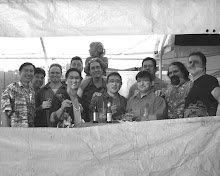I can hardly believe it. I’m moving about 3000 miles away from my dojo in Seattle, WA, to Brooklyn, NY. A bit of a rough weekly commute, so I’ve got to say some kind of “goodbye” or at least “smell ya later”. I’m gonna miss the hell outta you guys.
I remember searching for a good place to train when I first arrived in Seattle back in 2000. It was a rough search, with many McDojos and places I felt overqualified to be a student (one “teacher” in a place I visited, after talking to him and feeling his technique, said unabashedly and without irony that I should be teaching him. That was mighty frustrating, and frankly… sad.), as well as a few good dojos that just didn’t fit what I was looking for.
In 2002, I was passed the number of Neil Yamamoto Sensei by a buddy I worked with and trained with for a bit. Having just been given a huge front of bullshit by Russell McCartney about “Aikijujutsu”, I was a bit wary of anyone teaching such stuff. I called Neil and came with the tough questions about lineage, etc. To his credit, he was very straightforward about Icho Ryu and his qualifications, and told me to come train and see if it worked for me. I liked Neil’s no-nonsense approach, so I went to a class.
The class was held at the Seattle Jujutsu Club (at its first location, in Rainier Valley), which is one of the aforementioned GOOD dojos that didn’t fit what I was looking for (though I continued to train on and off occasionally with Aaron Fields Sensei and his guys of the SJC/Seatown Sambo as they are incredibly talented and tough “Hi, Laura!”). The club was in a HUGE old warehouse, and our space was essentially a loading-dock garage type space, with garage doors that were open all summer long, letting in the smell of blackberries. In the winter however, it was a horrid place, a frozen-hell of purple toes and propane-heat addled brains.
In my first class there were a couple other dudes and me, and of course, Neil, who had decided to go back to teaching after some time away from it. All I really remember from the first class is that I could not throw Neil. I couldn’t joint-lock him. I couldn’t torque his limbs. Neil, however, could do all that stuff to me, despite my height/reach/weight advantage. He granted that I had some skills, but I could achieve so much more. I was hooked.
Unlearning and relearning was torturous for so many years. It was an exercise in frustration shared by me and my dojo-mates in the TNBBC. We learned to be critical of ourselves and each other in a very affirming, but not ego-boosting way. If the baseline is “That sucks!” then “That sucks less.” is a pretty good step up the ladder of self-improvement.
We’ve moved about a bit over the years, following the SJC/Seatown Sambo to its location in that musty-but-cool basement in the U. District (great in winter, awful in summer—opposite of the Rainier Valley place), and then into our current location at the Seattle School of Aikido in University Heights, where we share space with Aikido and Shinto Ryu, a Meiji era sword style that a few TNBBCers hold advanced ranks in. Finally, we have a great combination of air, light, heat, cool, good mats, and appropriate ceiling height. Congrats to the TNBBC on their hard work to preserve the Seattle School of Aikido and for landing in such a great space. Big ups to the guys in our group who have worked so hard to give us a great place to train!
I want to thank my friends in the TNBBC for being there for me over the years. These guys have been my inspirations, my confidants, my drinkin’ buddies, my Ukes and Nages, my sounding boards, my students and my teachers (often in the same few minutes), my favorite jokesters and philosophers, and an all around batch of good, sweet, funny, talented, thoughtful, hard-working, courageous people that I am proud to call my friends. And I’m damn lucky to have trained with all of you guys.
Neil is of course included in the above sentiments about all of the TNBBC, but as he has made all this possible, I have to extend another note of gratitude and appreciation. Thank you, Neil, for taking a chance on me as a student, especially after my post-McCrapney interrogation (boy, that was an awkward phone-call/interview thingy!). I owe you a huge pile of thanks for helping me better understand body mechanics, structure, and power release, in fact you are the reason I started to pay attention to that stuff in a serious way. Since starting with you, I have found a new love for martial arts and am so interested in continuously working on my foundation/basics—these ARE the advanced techniques. I also have appreciated how you’ve let me and other students seek skills elsewhere (and often encouraged it for some), but have always been able to relate to us when we came back to the TNBBC, and show how these skills relate to the frame and skill-set we’ve been developing over the years. Mostly, as with the other guys, I want to thank you for your constant and amazing friendship that has meant so much to me over these years. Thank you for everything, Neil Yamamoto Sensei (Yes, I know you don’t like to be called Sensei, but gimme a break this time).
Thank you, TNBBC, for enriching my life so much. Seattle Icho Ryu has given me the best friends of my 30s and I hope on into the rest of my life. I will continue to represent the TNBBC spirit in all of my Martial Arts endeavors in NY. I’ll miss you guys, but you”ll always have a couch in NY with your name(s) on it. I love you guys!

